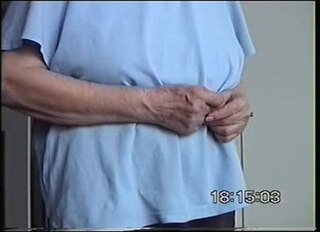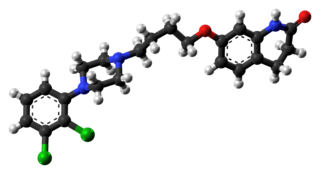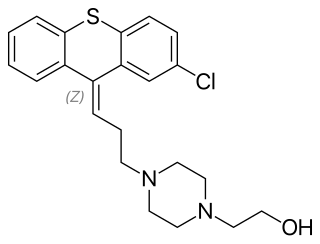Diagnosis
| | This section is empty. You can help by adding to it. (July 2022) |
| Psychomotor agitation | |
|---|---|
| Other names | Pacing |
| Specialty | Psychiatry, emergency medicine |
Psychomotor agitation is a symptom in various disorders and health conditions. It is characterized by unintentional and purposeless motions and restlessness, often but not always accompanied by emotional distress. Typical manifestations include pacing around, wringing of the hands, uncontrolled tongue movement, pulling off clothing and putting it back on, and other similar actions. [1] In more severe cases, the motions may become harmful to the individual, and may involve things such as ripping, tearing, or chewing at the skin around one's fingernails, lips, or other body parts to the point of bleeding. Psychomotor agitation is typically found in various mental disorders, especially in psychotic and mood disorders. It can be a result of drug intoxication or withdrawal. It can also be caused by severe hyponatremia. The middle-aged and the elderly are more at risk to express it.
Psychomotor agitation overlaps with agitation generally, such as agitation in predementia and dementia; see Agitation (dementia) for details.
People experiencing psychomotor agitation may feel the following emotions or do the following actions. Some of these actions are not inherently bad or maladaptive, but they can have maladaptively excessive versions. For example, self-hugging can be therapeutically advisable, but self-hugging as a component of a set of motor agitation movements is a sign of psychomotor agitation.[ citation needed ]
Causes include: [2]
As explained in a 2008 study, in people with mood disorders there is a dynamic link between their mood and the way they move. [5]
People showing signs of psychomotor agitation may be experiencing mental tension and anxiety, which comes out physically as:
These activities are the subconscious mind's way of trying to relieve tension[ citation needed ]. Often people experiencing psychomotor agitation feel as if their movements are not deliberate.
Sometimes, however, psychomotor agitation does not relate to mental tension and anxiety.
Recent studies found that nicotine withdrawal induces psychomotor agitation (motor deficit). [6] [7] [8] [9]
In other cases, psychomotor agitation can be caused by antipsychotic medications. For instance, akathisia, a movement disorder sometimes induced by antipsychotics and other psychotropics, is estimated to affect 15-35% of patients with schizophrenia. [10] [11]
| | This section is empty. You can help by adding to it. (July 2022) |
A form of self-treatment arises in that many patients develop stimming in a natural, unplanned, and largely nonconscious way, simply because they coincidentally discover behavior that brings some relief to their psychomotor agitation, and develop habits around it. Stimming has many forms, some quite adaptive and others maladaptive (for example, excessive hand-wringing can injure joints, and excessive rubbing or scratching of skin can injure it). Another form of self-treatment that arises not uncommonly is self-medication, which unfortunately can lead to substance use disorders such as alcohol use disorder.[ citation needed ]
Whereas stimming is a nonpharmacologic but undirected and sometimes harmful amelioration, directed therapy tries to introduce another and generally better nonpharmacologic help in the form of the following lifestyle changes, to help a person to reduce their anxiety levels: [5]
Because nonpharmacologic treatment by itself is often not enough, medications are also often used. Intramuscular midazolam, lorazepam, or another benzodiazepine can be used both to sedate agitated patients and to control semi-involuntary muscle movements in cases of suspected akathisia.
Droperidol, haloperidol, or other typical antipsychotics can decrease the duration of agitation caused by acute psychosis, but should be avoided if the agitation is suspected to be akathisia, which can be potentially worsened. [12] Also using promethazine may be useful. [13] Recently, three atypical antipsychotics, olanzapine, aripiprazole and ziprasidone, have become available and FDA approved as an instant release intramuscular injection formulations to control acute agitation. The IM formulations of these three atypical antipsychotics are considered to be at least as effective or even more effective than the IM administration of haloperidol alone or haloperidol with lorazepam [14] [15] [16] (which is the standard treatment of agitation in most hospitals) and the atypicals have a dramatically improved tolerability due to a milder side-effect profile.
In those with psychosis causing agitation, there is a lack of support for the use of benzodiazepines alone, however they are commonly used in combination with antipsychotics since they can prevent side effects associated with dopamine antagonists. [17]

Antipsychotics, previously known as neuroleptics and major tranquilizers, are a class of psychotropic medication primarily used to manage psychosis, principally in schizophrenia but also in a range of other psychotic disorders. They are also the mainstay, together with mood stabilizers, in the treatment of bipolar disorder. Moreover, they are also used as adjuncts in the treatment of treatment-resistant major depressive disorder.

Catatonia is a complex neuropsychiatric behavioral syndrome that is characterized by abnormal movements, immobility, abnormal behaviors, and withdrawal. The onset of catatonia can be acute or subtle and symptoms can wax, wane, or change during episodes. It has historically been related to schizophrenia, but catatonia is most often seen in mood disorders. It is now known that catatonic symptoms are nonspecific and may be observed in other mental, neurological, and medical conditions. Catatonia is now a stand-alone diagnosis, and the term is used to describe a feature of the underlying disorder.

Chlorpromazine (CPZ), marketed under the brand names Thorazine and Largactil among others, is an antipsychotic medication. It is primarily used to treat psychotic disorders such as schizophrenia. Other uses include the treatment of bipolar disorder, severe behavioral problems in children including those with attention deficit hyperactivity disorder, nausea and vomiting, anxiety before surgery, and hiccups that do not improve following other measures. It can be given orally, by intramuscular injection, or intravenously.

Haloperidol, sold under the brand name Haldol among others, is a typical antipsychotic medication. Haloperidol is used in the treatment of schizophrenia, tics in Tourette syndrome, mania in bipolar disorder, delirium, agitation, acute psychosis, and hallucinations from alcohol withdrawal. It may be used by mouth or injection into a muscle or a vein. Haloperidol typically works within 30 to 60 minutes. A long-acting formulation may be used as an injection every four weeks by people with schizophrenia or related illnesses, who either forget or refuse to take the medication by mouth.

Typical antipsychotics are a class of antipsychotic drugs first developed in the 1950s and used to treat psychosis. Typical antipsychotics may also be used for the treatment of acute mania, agitation, and other conditions. The first typical antipsychotics to come into medical use were the phenothiazines, namely chlorpromazine which was discovered serendipitously. Another prominent grouping of antipsychotics are the butyrophenones, an example of which is haloperidol. The newer, second-generation antipsychotics, also known as atypical antipsychotics, have largely supplanted the use of typical antipsychotics as first-line agents due to the higher risk of movement disorders in the latter.

Risperidone, sold under the brand name Risperdal among others, is an atypical antipsychotic used to treat schizophrenia and bipolar disorder. It is taken either by mouth or by injection. The injectable versions are long-acting and last for 2–4 weeks.

Ziprasidone, sold under the brand name Geodon among others, is an atypical antipsychotic used to treat schizophrenia and bipolar disorder. It may be used by mouth and by injection into a muscle (IM). The IM form may be used for acute agitation in people with schizophrenia.

Olanzapine, sold under the brand name Zyprexa among others, is an atypical antipsychotic primarily used to treat schizophrenia and bipolar disorder. For schizophrenia, it can be used for both new-onset disease and long-term maintenance. It is taken by mouth or by injection into a muscle.

Akathisia is a movement disorder characterized by a subjective feeling of inner restlessness accompanied by mental distress and an inability to sit still. Usually, the legs are most prominently affected. Those affected may fidget, rock back and forth, or pace, while some may just have an uneasy feeling in their body. The most severe cases may result in poor adherence to medications, exacerbation of psychiatric symptoms, and, because of this, aggression, violence, and/or suicidal thoughts. Akathisia is also associated with threatening behaviour and physical aggression in mentally disordered patients. However, the attempts to found potential links between akathisia and emerging suicidal or homicidal behaviour were not systematic and were mostly based on a limited number of case reports and small case series. Apart from these few low-quality studies, there is another more recent and better quality study that concludes «akathisia cannot be reliably linked to the presence of suicidal behaviour in patients treated with antipsychotic medication».

Perphenazine is a typical antipsychotic drug. Chemically, it is classified as a piperazinyl phenothiazine. Originally marketed in the United States as Trilafon, it has been in clinical use for decades.

Aripiprazole, sold under the brand names Abilify and Aristada, among others, is an atypical antipsychotic. It is primarily used in the treatment of schizophrenia and bipolar disorder; other uses include as an add-on treatment in major depressive disorder and obsessive compulsive disorder (OCD), tic disorders, and irritability associated with autism. Aripiprazole is taken by mouth or via injection into a muscle. A Cochrane review found low-quality evidence of effectiveness in treating schizophrenia.
Dyskinesia refers to a category of movement disorders that are characterized by involuntary muscle movements, including movements similar to tics or chorea and diminished voluntary movements. Dyskinesia can be anything from a slight tremor of the hands to an uncontrollable movement of the upper body or lower extremities. Discoordination can also occur internally especially with the respiratory muscles and it often goes unrecognized. Dyskinesia is a symptom of several medical disorders that are distinguished by their underlying cause.

Amisulpride is an antiemetic and antipsychotic medication used at lower doses intravenously to prevent and treat postoperative nausea and vomiting; and at higher doses by mouth to treat schizophrenia and acute psychotic episodes. It is sold under the brand names Barhemsys and Solian, Socian, Deniban and others. At very low doses it is also used to treat dysthymia.
Extrapyramidal symptoms (EPS) are symptoms that are archetypically associated with the extrapyramidal system of the brain's cerebral cortex. When such symptoms are caused by medications or other drugs, they are also known as extrapyramidal side effects (EPSE). The symptoms can be acute (short-term) or chronic (long-term). They include movement dysfunction such as dystonia, akathisia, parkinsonism characteristic symptoms such as rigidity, bradykinesia, tremor, and tardive dyskinesia. Extrapyramidal symptoms are a reason why subjects drop out of clinical trials of antipsychotics; of the 213 (14.6%) subjects that dropped out of one of the largest clinical trials of antipsychotics, 58 (27.2%) of those discontinuations were due to EPS.

Asenapine, sold under the brand name Saphris among others, is an atypical antipsychotic medication used to treat schizophrenia and acute mania associated with bipolar disorder as well as the medium to long-term management of bipolar disorder.

Zuclopenthixol, also known as zuclopentixol, is a medication used to treat schizophrenia and other psychoses. It is classed, pharmacologically, as a typical antipsychotic. Chemically it is a thioxanthene. It is the cis-isomer of clopenthixol. Clopenthixol was introduced in 1961, while zuclopenthixol was introduced in 1978.

Tiapride is a drug that selectively blocks D2 and D3 dopamine receptors in the brain. It is used to treat a variety of neurological and psychiatric disorders including dyskinesia, alcohol withdrawal syndrome, negative symptoms of psychosis, and agitation and aggression in the elderly. A derivative of benzamide, tiapride is chemically and functionally similar to other benzamide antipsychotics such as sulpiride and amisulpride known for their dopamine antagonist effects.

Pimavanserin, sold under the brand name Nuplazid, is an atypical antipsychotic which is approved for the treatment of Parkinson's disease psychosis and is also being studied for the treatment of Alzheimer's disease psychosis, schizophrenia, agitation, and major depressive disorder. Unlike other antipsychotics, pimavanserin is not a dopamine receptor antagonist.

Brexpiprazole, sold under the brand name Rexulti among others, is a medication used for the treatment of major depressive disorder, schizophrenia, and agitation associated with dementia due to Alzheimer's disease. It is an atypical antipsychotic.

Aripiprazole lauroxil, sold under the brand name Aristada, is a long-acting injectable atypical antipsychotic that was developed by Alkermes. It is an N-acyloxymethyl prodrug of aripiprazole that is administered via intramuscular injection once every four to eight weeks for the treatment of schizophrenia. Aripiprazole lauroxil was approved by the U.S. Food and Drug Administration (FDA) on 5 October 2015.